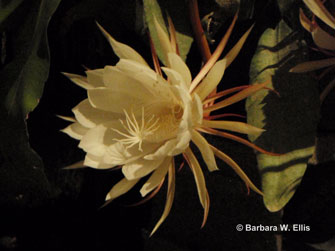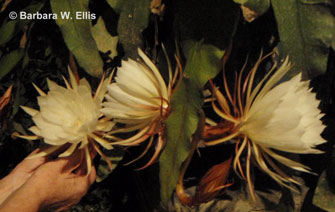I wasn’t going to post again so soon – after all, I’m a newbie at it – but I have to share about the impromptu garden parties at my house last weekend. Nighttime is a fairly strange time to gather in most gardens, but my friends and I had a reason: My night-blooming cereus bloomed for the first time.
Although mine is a common species – Epiphyllum oxypetalum, I think, although its flowers are considerably larger than species descriptions indicate – this is no ordinary night-blooming cereus. It has a history. A friend gave me my plant. It’s a piece of a plant originally passed down from her great grandmother, Sarah Jean Tindal, from Sumter, South Carolina, to her mother, Precious Tindal Butler. Precious took the plant to Philadelphia in her 20s, and eventually passed it along to my friend, Helen Butler Delaney, who has had it for 20 years. The history passed down with the plant states that “the original piece came from a railroad man who brought it up from Florida.” It has never bloomed for my friend Helen, although a piece given to her brother seven or eight years ago bloomed once.
From the start I was determined to make this non-blooming plant do more for me than it ever had for my friend. After all, in a most-beautiful foliage plant pageant, epiphyllums would be laughed off the stage before the talent competition. Plus the “piece” Helen gave me was a honking big thing in a 10 inch pot that filled up the back of my station wagon. It had to be more than just an enormous foliage plant. (The botanical name is misleading: It’s from epi, upon, and phylon, leaf, and stems from the fact that the flowers seem to appear on the leaves, although the “leaves” are actually flattened, fleshy stems.)
I turned to the internet when my library didn’t reveal much more than basic care, with little information on how or why plants bloom. Google led me to Joseph Dougherty’s site, and after reading the articles and e-mailing with Mr. Dougherty, I found the answer: Plant abuse.
Ephphyllums need a cool dry dormancy in winter, said Dougherty, and plants that have slightly yellowed, hungry look bloom best. Here’s his e-mailed advice: “Plants must be root-bound and get lots of sun in the season preceding flowering. If foliage is dark green, then they’re not getting enough sunlight. Foliage must be yellowish to indicate enough light is being absorbed. Then once it is rootbound it will bloom. So don’t overpot. Also let it dry between waterings. Ironically, the plants that look a little abused tend to be the ones that flower most heavily. Don’t love it to death!”
So my plant got moved to more sun (it had lush, dark green leaves when I got it), and spent the winter in my cool garage-greenhouse, where temperatures hover around 50°F. I didn’t water it from November to April unless the leaves looked like they were shriveling.
I first spotted the tiny, red fuchsialike flower buds that appeared along the leaf margins several weeks ago. They lengthened quickly, ultimately ranging from 11 to 13 inches long. About a week before they opened, the buds, which had been hanging down, turned upward. In all, the plant produced a dozen fragrant blooms that opened over three nights. Next time, I’ll schedule a dinner party to coincide, since I now know better how to tell what night they’ll open-the sepals on the outside of the bloom fold back slightly and a hint of white shows on the tip of the bud. The flowers began opening about 8:30 or 9:00 p.m., and were fully open by 10:00 p.m. They were limp and hanging straight down by the time I got up the next morning at 6:00 a.m. to walk the dogs.
I’m happy to say my friend Helen doesn’t hate me for getting my plant to bloom before hers did. She left here steeled to subject her luxurious, dark green plant to considerably more abuse.



